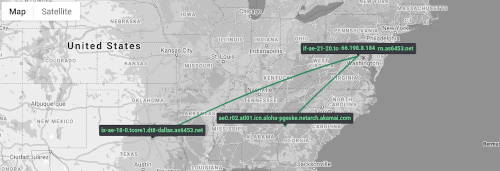Traceroute Online - Trace and Map the Packets Path
Utilize traceroute online to perform an advanced visual traceroute that maps and enriches output from
mtr. With ASN and Geolocation data to better understand the network path.
Traceroute Tool Output
If you are familiar with the regular traceroute used on Linux operating systems or even Windows
(tracert), you will notice that the output of this tool is somewhat different. That is because the
tool utilizes the mtr tool to gather additional network telemetry. We then parse
the results and enrich further with additional network related information.
Want the raw mtr output? Try this page.
About Traceroute Online
Using traceroute online is different from running it from your own computer. Usually a traceroute will be initated from your computer when troubleshooting network outages or packet loss. It allows you to see where the outage or packet loss is occuring.
The output may show the hop where the latency is abnormal, packet loss is occurring or packets simply don’t get past.
When using traceroute online the originating system is our system running in a data centre located in Dallas, Texas. The advantage of this is you can test from our system to anywhere in the world and get a view of the network connectivity that is independent from your current location.
Mapping Traceroute
Visualization of network paths using traceroute can be a valuable way to understand the geographic aspects of an Internet connection. The online traceroute takes the mtr raw output, parses it, and plots the results on a world map. If the hops are determined to be only present in the US then the map shown is the USA only. Starting from the our server on the east coast of the USA, traceroute online this test will show response times for each responding hop in the path. Please note that geolocation is not an exact science and discrepancies may be found on occasion in the mapped results.

As you will see from the traceroute mapping the plots between hops all originate from the server that is performing the test. By using this method it is clear to see the response time from the source to the destination hop. Attempting to plot a traceroute on a map similar to what can be seen in the movies is actually quite difficult due to the problem of getting accurate IP address geolocation data.
Traceroute Response Times
The response time chart shows the MTR traceroute data in a chart. Using a chart such as the one shown here clearly shows hops where variation in response times is apparent, possibly due to network instability.
Obviously we want our response times to be as small as possible in order to have the best experience when using the Internet. Keep in mind that there are limits to how low a response time can get when pinging the other side of the world. These limits are based on science and physics so upgrading your server will not suffice. A decent response time to the other side of the world is typically in the low 200ms range. While access to Google services are commonly seen under 10ms if you are on a good connection.
Did you know routers can prioritise traffic? It is common to give ICMP packets a lower priority than other traffic. If this is the case the response times listed in the traceroute may not accurately depict the application response times. On the other hand if there is a slow hop for ICMP it is likely this router is having a bad day and the application traffic will also be slow through this hop.
Other Traceroute Tools
Tracepath, Tracert, tcptraceroute, traceroute and mtr
are all similar tools that test the network path using either UDP, ICMP or TCP. See the wikipedia article for more details on the technical side of traceroute and the tools that we run.
Yet another tool that can perform a traceroute is the famous open source port scanner Nmap.
Attack Surface Mapping
Knowing the attack surface is an essential part of securing any network. For indepth security testing and attack surface mapping check out hackertarget.com.